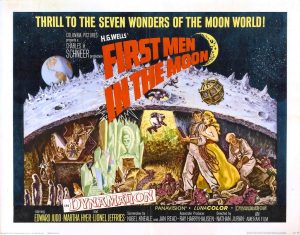
Someone who had read H. G. Wells’ “First Men in the Moon” and then sat down to watch this adaptation may well be aghast at the opening sequences, which deal with a “modern-day” mission to the moon, as opposed to the 1899 setting of the novel. But stay with it, and you’ll find that the contemporary setting is just a framework to introduce us to the story basically as Wells wrote it: a fantasy about a trip to the moon in the Victorian era.
So why did the filmmakers choose to frame the story in this flashback format? Simple. At the time Wells wrote his novel, the very idea of a trip to the moon was fantastical; heavier-than-air flight hadn’t even been invented yet, let alone space travel. But by the time the movie was made in the ’60s, we were on our way to the moon, JFK having stated it as an objective. While still a gripping, exciting idea, a trip to the moon was no longer a fantasy, but a hardware-based reality. (In fact, the modern spacecraft depicted are very much like what ultimately made the trip in 1969: an orbiting command module and a spidery-legged landing unit, not the old saucer-craft or delta-winged ships of the ’50s. So while “dated,” these opening scenes aren’t foolish. And the international crew on board–since it’s a mission of the UN, not just the USA–reflect today’s reality of the International Space Station; reality has finally caught up with this fiction.)
So, how to make what was becoming a here-and-now reality (in 1964, the Gemini missions were beginning, paving the way for the Apollo program) back into a magical fantasy? By having the modern explorers discover evidence that their “first” lunar landing had been predated by a trip in 1899! One of the voyagers, Bedford (Edward Judd) is found to be still alive and very old at the time of the contemporary mission, and his tale is told in flashback, a structure much like that of “Little Big Man” or “Titanic.”
Some other changes are made as well. The long trip to the moon reads well in the book, but if filmed as described (the two men float in darkness and silence inside the sphere, as the unsecured baggage gradually gravitates to the center of the “room”), it would have made incredibly boring viewing, so the scripter adds a few vignettes to lighten the journey. The riot of plant life that erupts across the lunar surface at sunrise would have elicited hoots from a modern audience, and so is eliminated on screen; yet the just as unscientific touch of having the men cavort around the surface in diving suits (which would have swelled up like balloons in the vacuum of space, to say nothing of the men’s exposed hands) clearly signal that this is, after all, a fantasy, and not “true” science fiction. And Cavor’s audiences with the Grand Lunar, which take place in the book after Bedford has returned to earth, are reduced in the movie to a single hearing which happens while Bedford and his girl (keep reading) are still on the moon: rather than just hear it described, we see it happen, which is, of course, a much more cinematic handling.
While Bedford and Cavor make a stag trip in the novel, the movie adds a woman, Kate Callender (Martha Hyer), Bedford’s fiancee. Her inclusion isn’t gratuitous; by being in places on the moon where Bedford and Cavor aren’t, she helps the story cover more ground in less time than otherwise would have been the case. Besides, she’s the sort of woman whom Wells, a feminist and self-described “free thinker,” would have liked: she’s tough, smart, brave, and doesn’t put up with much. She’s the epitome of the “new woman” of that turn-of-the-century era, the sort of restless woman who was learning such manly things as how to operate a newfangled typewriting machine so she could get a job in an office. As an American in Britain, she’s a bit of a traveler herself; she symbolizes Britain’s exploratory, empire-building, “new world”-seeking, colonizing impulses (indeed, upon arrival, Cavor claims the moon for Her Majesty); and she’s the only person involved in the mission who has enough sense to bring a gun.
While all the performances are equal to the task (especially Lionel Jeffries’ comically high-strung Cavor, plus a one-scene appearance by the impish Miles Malleson as a city clerk), this isn’t an actors’ picture, but an effects picture. And Ray Harryhausen delivers, as he always does. The Grand Lunar in particular is a haunting, whispery presence, curiously but coolly regarding these human intruders and weighing their fates. Even the music works: Laurie Johnson’s score, evocative of an awed sense of wonder married to a towering adventure, is worthy of Bernard Hermann.

